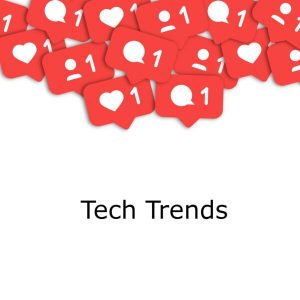Total digital ad spending worldwide exceeds $ 450 billion. By 2024, that figure will rise to $ 645 billion.
This kind of spending means crowded ad platforms, which makes it more difficult to stand out.
If your business has a five- or six-figure digital advertising budget, you can put more money behind campaigns. But this is exactly what has caused online ad prices to increase by an average of 45% on Google and Facebook (and up to 1000% in some sectors).
If you don’t have those kinds of resources or would rather not continually increase spending, you need to think outside the box.
In this article, we’ll talk about some less saturated digital advertising strategies you can use to get ahead. We’ll also show you what it takes to create advertising that gets people to act.
Advertising in the current landscape
To steal customers away from competitors without throwing endless amounts of money at major advertising platforms, work smarter, not harder.
This means relying on creativity and quality.
It also means leveraging data and intent to optimize your advertising better.
Before you begin using tactics to hit your goals, tap into your analytics and search data. Understand how users interact with your pages and ask yourself:
- Which pages get the most traffic?
- Where do visitors spend the most time?
- Which actions do visitors take?
- Which terms are people using to search for your products?
Use this information to identify what interests your audience.
Dig into your sales data too. Detail the customer demographics that purchase certain products or services. This will help you build a picture of the target audience that will underpin your digital advertising strategy.
It will also ensure you’re not “spraying and praying” with campaigns—and you’re not wasting your budget.
Next, look at the current state of your market:
- Who’s interested in your product or services?
- How many of them are likely to buy?
- Who are your competitors?
- What do their advertising strategies look like (i.e. What types of ads are they running, and on which platforms?)
This is most likely covering old ground, but it helps to know that your audience and market position remain relevant before investing in something that may fall flat.
By conducting competitive research, you can spot new opportunities to grab audience share.
For example, instead of bidding on the same terms as rival platform Asana, which will probably be more expensive, monday.com bids on its competitor’s name:
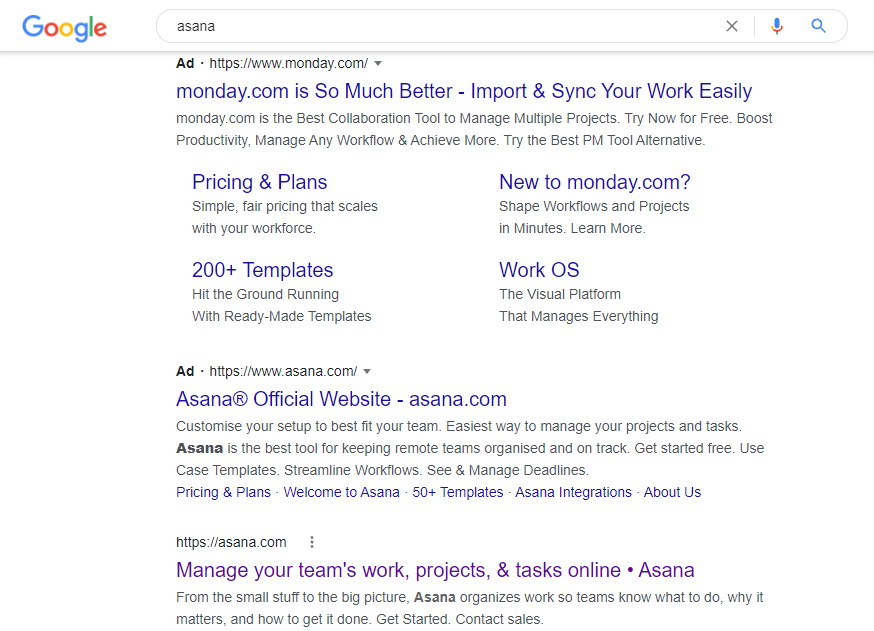
Because of lower competition, competitor brand names tend to be cheaper. Monday.com can also gain brand awareness and competitive advantage by appearing in front of a relevant audience.
Putting more constraints on your creativity are two significant challenges:
1. Ad blockers
Research shows that over 42% of internet users worldwide now use ad blockers to reduce how much advertising they see.
Men tend to use ad blockers more than women, and they’re most popular among men aged 16-34.
Consider how ad blocking usage may impact reaching your target audience.
It’s also important to consider why people decide to use ad blockers:
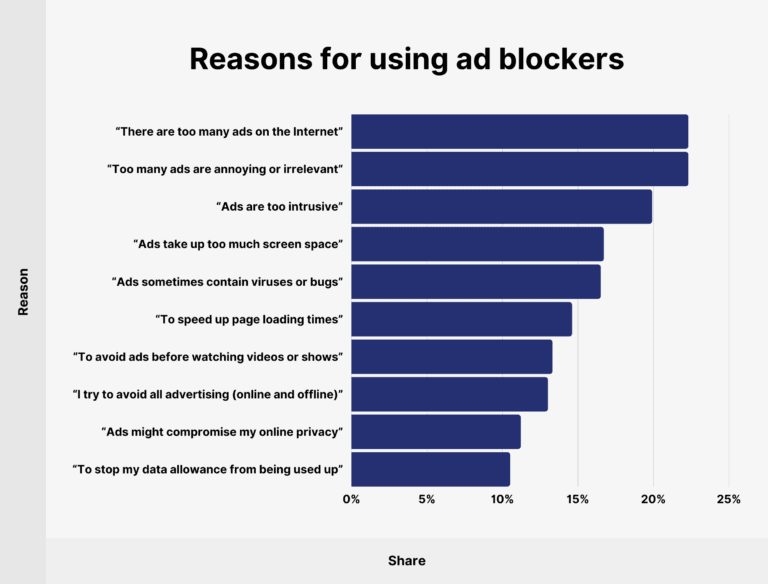
While there’s nothing you can do about there being too many ads on the internet, ad irrelevance, intrusiveness, and size are all elements to consider.
Use what you know about your audience to create relevant ads, but proceed with caution.
Popup ads, full-screen mobile ads, and auto-playing and prestitial video ads, for example, all have high disapproval ratings from users, pushing them towards using ad blockers.
2. User privacy
The rollout of GDPR and anti-cookie policies by major browsers have impacted real-time bidding platforms and cookie-reliant advertising methods.
Mobile analysts say that fewer than one in three users are likely to grant permission, while 96% of U.S. users opted out of app tracking in the iOS 14.5 update.
To reach privacy-focused users, performance marketing platforms recommend that advertisers use contextual advertising, first-party data, and consent-based targeting.
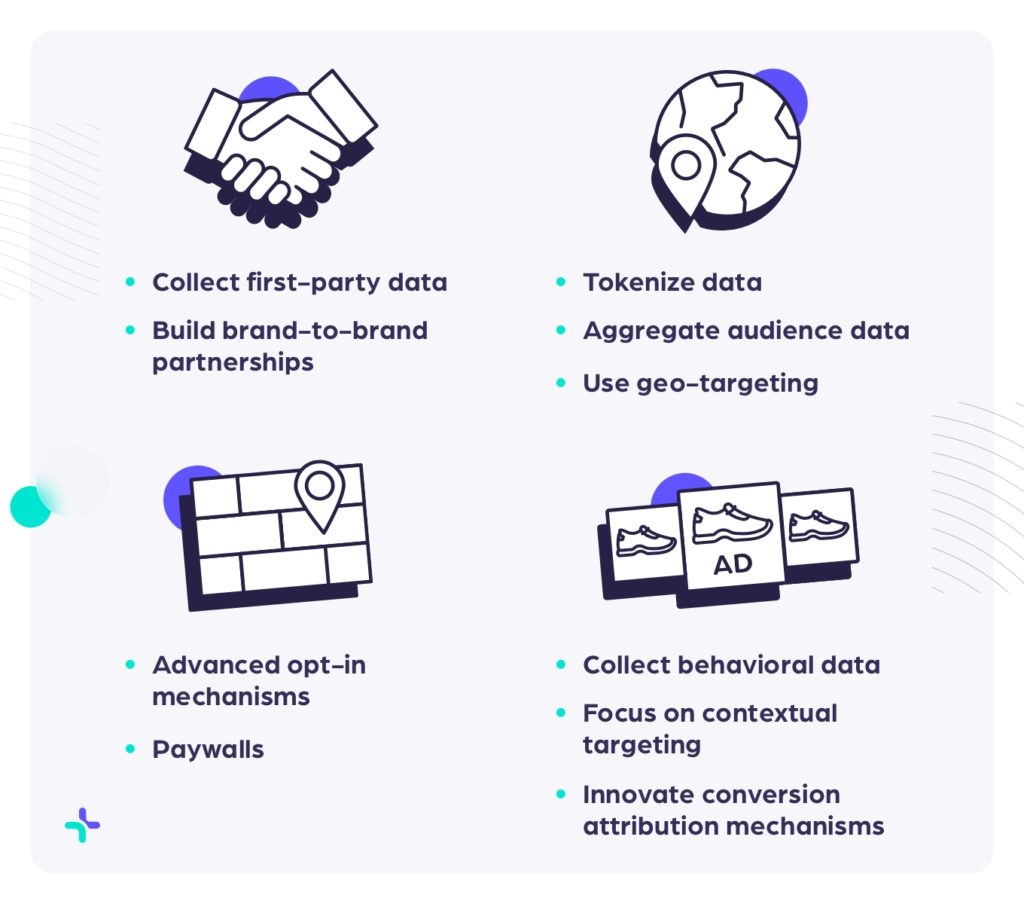
What these challenges make clear is that your advertising needs to do three things:
1. Grab attention
2. Build trust
3. Offer value
Let’s look at four digital advertising strategies to help you achieve these aims.
Use content advertising to fight rising costs
The concept of content advertising is a relatively new one. Influencer Marketing defines it as:
“…creating content that will be promoted through paid distribution channels like sponsored placements, advertisements, and pay-per-click campaigns. Its primary focus is to create brand awareness by putting your content in front of an audience that will find it engaging or compelling, aka your target audience.”
Content advertising taps into the benefits of content marketing to provide consumers with interesting, valuable resources that build trust in a brand. Except it does it without relying on organic search engine optimization to make an impact.
The idea is to create a piece of content that’s so relevant to your audience that they don’t care how it’s promoted. They just want to consume it.
In this sense, it’s indistinguishable from organic content. It also shouldn’t be confused with native ads, which rely on consumers being unable to work out which content is promoted and which is organic.
For example, HubSpot used content advertising to promote a free guide on brand building to a targeted audience on Facebook:
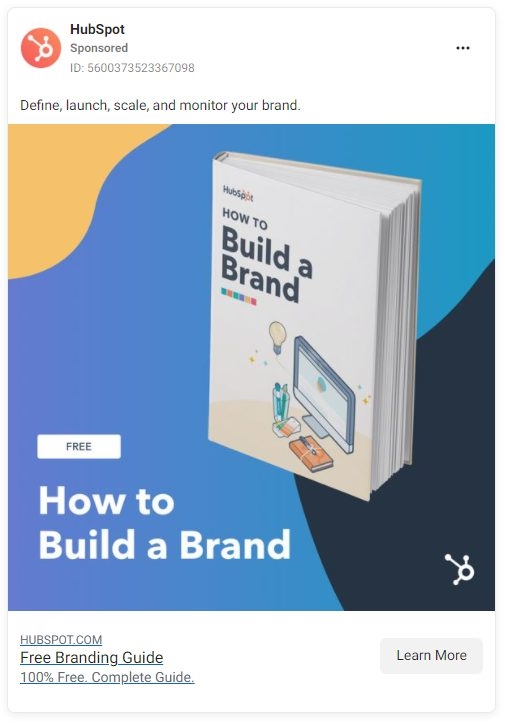
This ad mirrors the look and feel of the content Hubspot regularly posts on its timeline, meaning people don’t feel they’re being blatantly advertised to:
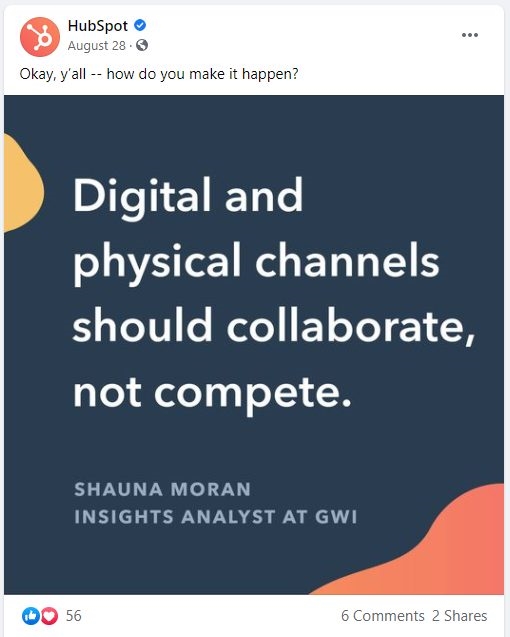
Proquo promoted its brand strategy guide using Google Ads to build brand awareness by targeting top of the funnel search terms such as “brand marketing guide”:

Like content marketing assets, both brands aim to capture attention and gain conversions on the strength of the content.
An industry report or “ultimate” guide offers more to the target audience than a general “top tips” blog post. It’s also better suited to those in the brand awareness stage than an ad offering a product tour or free trial.
What both do differently from typical content marketing pieces is speed up lead generation by directing prospects to a landing page to capture details. Here’s Proquo’s lead generation landing page:

By doing this, they’re able to progress prospects through the funnel more quickly, reducing cost per acquisition.
Another great use of content advertising can be found in email marketing. This involves securing a placement in newsletters with a focused audience.
Take Really Good Emails, which often link to content created by others:
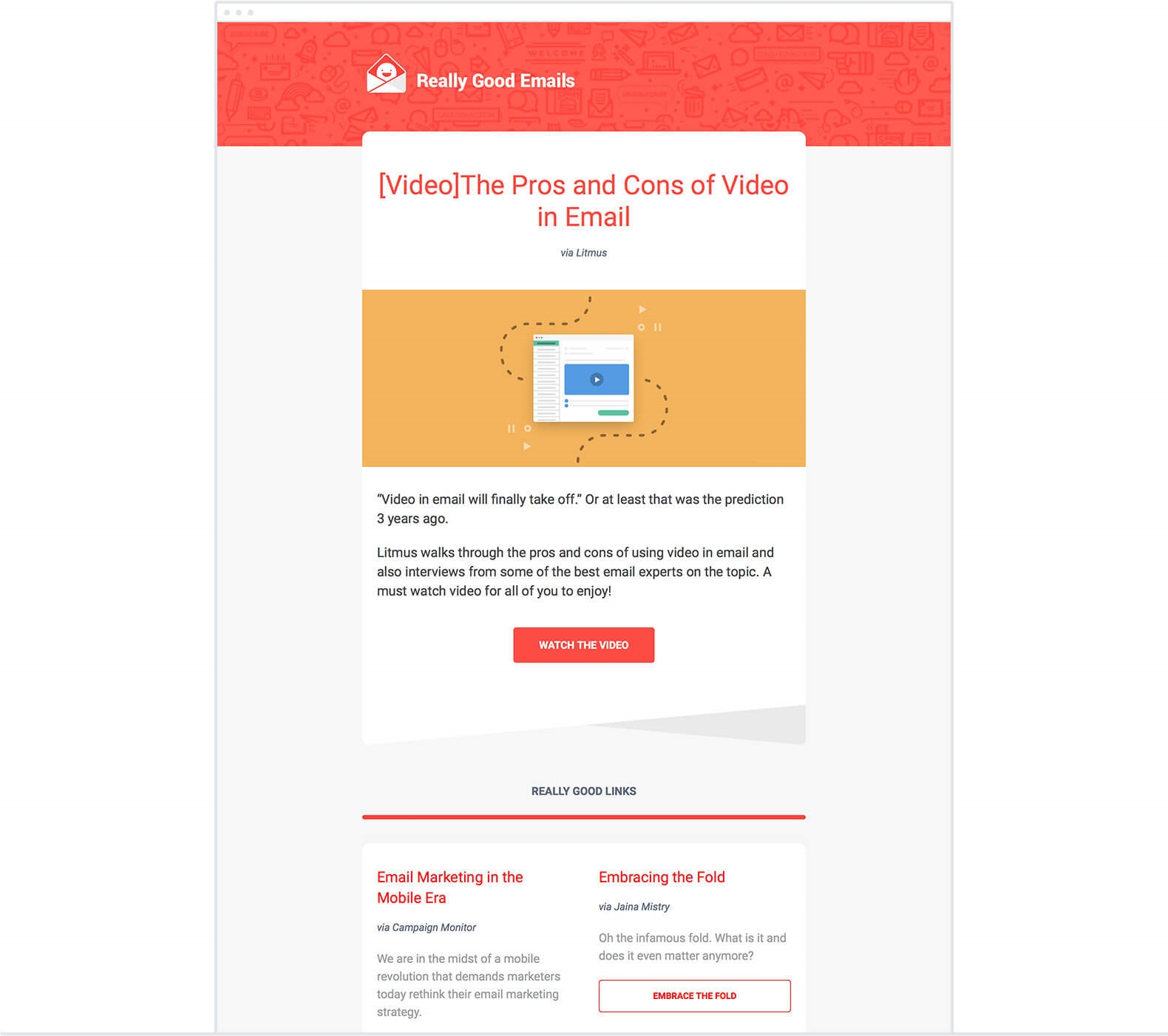
Because subscribers trust content recommended by Really Good Emails, they’re more likely to click on a link, giving brands the chance to access new markets.
The content marketing asset doesn’t have to be produced specifically for advertising.
Here’s what WordStream’s Dan Shewan had to say about an Adwords (now Google Ads) guide it advertised on Facebook:
“We didn’t produce this particular guide with the express intention of advertising it on Facebook. Rather, we repurposed some original content into a downloadable guide format, then advertised it. Ultimately, it doesn’t matter if content is produced solely for a specific campaign or repurposed […] just that you have a tangible business goal in mind for each campaign, and that you segment your audience appropriately.”
Repurposing can help you minimize the time, effort, and money you spend creating content for ads and achieve some quick wins.
It also lets you minimize risk. If a piece of content has already been well-received by your target audience, there’s every chance it will go down well with new audiences.
Here are some tips for getting started with content advertising:
- Start with repurposing. Look at past marketing campaigns to identify successful content and test it with target audiences.
- Identify successful brands or industry leaders with a similar target audience and approach them about paid placements.
- Ensure content is relevant to your conversion funnel. For example, in the awareness stage use how-to guides, whitepapers, explainer videos, etc. In the consideration stage, use demo videos, webinars, free trials, etc.
- Above all else, ensure content delivers value.
Leverage Performance PR to build trust with cold traffic
Performance PR taps into an undisputed fact of SEO content marketing: backlinks are best.
It works by getting your site links featured on reputable publications or in influencer content that is typically hard to obtain. And those links can have a powerful impact on your industry reputation and web traffic.
A link on a popular website immediately puts your brand in front of a large audience, giving you access to cold traffic. The simple act of being mentioned on that website will also raise your profile.
Let’s look at a couple of examples.
Databricks
This Entrepreneur post on indispensable skills for data scientists is written by a team member at Databricks:
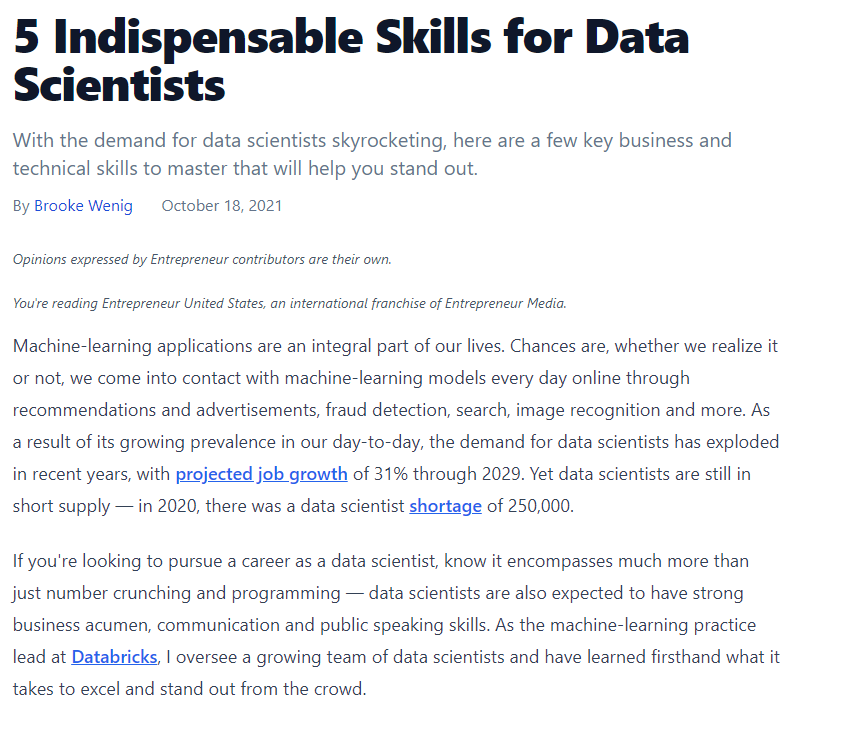
The fact that the content is featured on an established site like Entrepreneur indicates that it’s trustworthy.
That Databricks is contributing to Entrepreneur shows they know their stuff. The tips are valuable and intrigue the target audience to find out more about what they offer. The included link to their site makes that journey easy.
Kajabi
In this example, Promotion PR overlaps with influencer marketing.
By having its product reviewed and linked to by industry influencer Lane Sebring, Kajabi has raised the profile of its product.
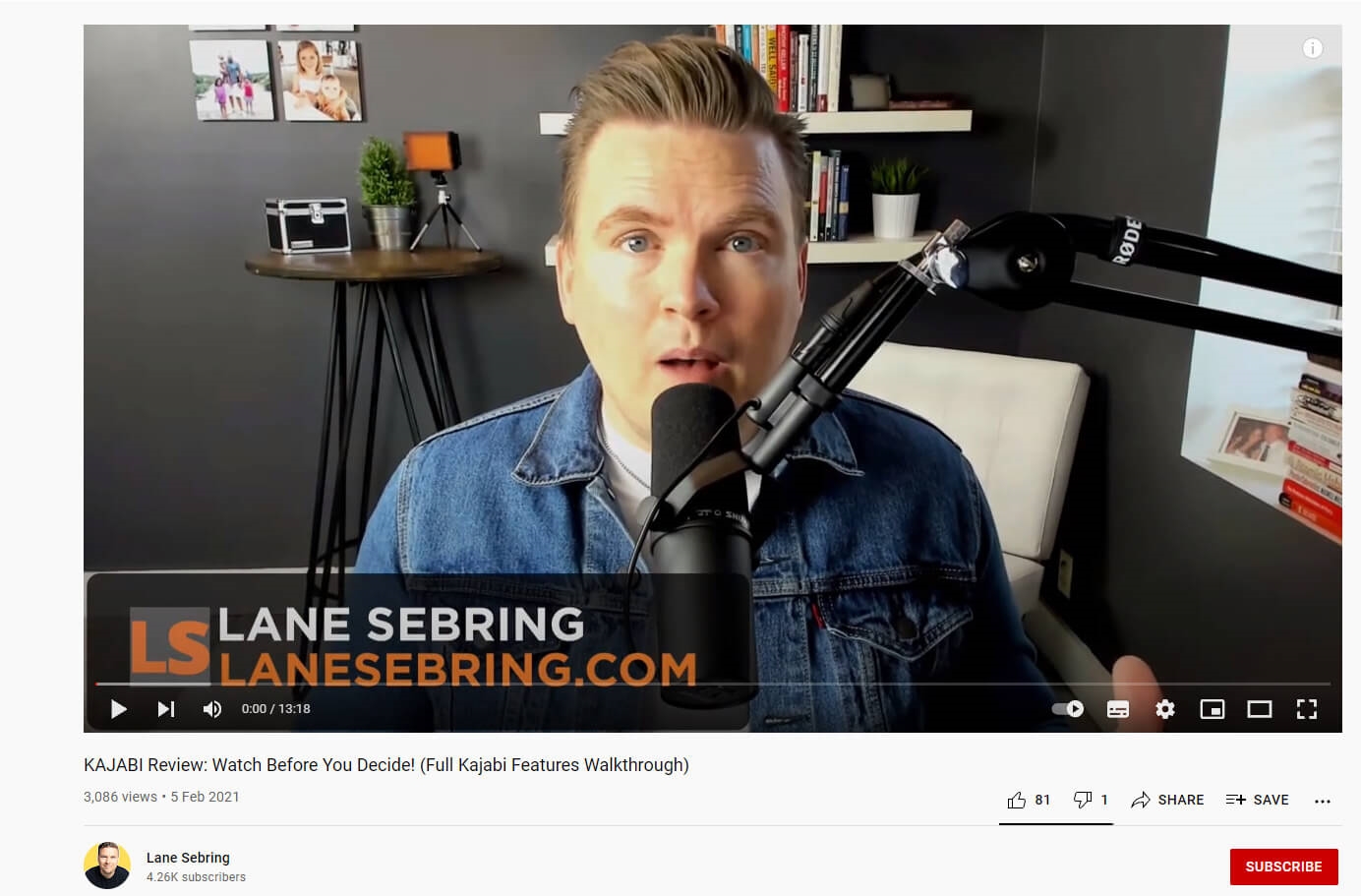
With studies showing as many as 92% of consumers trust an influencer more than an advertisement or traditional celebrity endorsement, this type of PR can have a more positive impact on Kajabi’s product than a typical display ad.
For fans of Lane’s content, his mention of Kajabi instantly makes it worthwhile. For someone stumbling across this content for the first time, Lane’s online following tells them that his opinion holds weight and the review is worth listening to. By signing up through Lane’s link, viewers can also grab a free trial and bonus templates.
But even without clicks, these links are working hard for their brands.
This is because high-quality backlinks (i.e. those from sites with a high domain rating) strongly correlate with higher rankings.
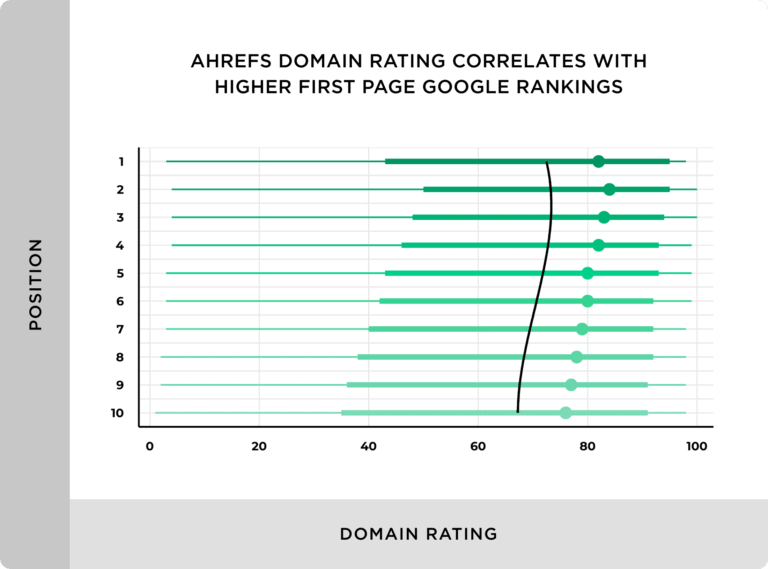
And the more of them your website has, the higher it will rank in search engines, giving you more traffic.
Additionally, high authority backlinks help to improve your Domain Authority and search presence.
For your advertising spend, you’re getting paid benefits and a boost to your search engine marketing campaigns. You’re also getting your brand in places where it’s not competing head-to-head with the competition.
And while you can share content across your own social channels or in newsletters, promotion is handled by the source. This gives your product or service a wide reach without having to invest in organic or paid content to promote it.
Promotion PR is built on relationships
Promotion PR thrives on the links you forge with agencies, publishers, and journalists.
You can build PR relationships by researching industry publications and influencers for paid PR opportunities and establishing long-term working connections.
Make sure to keep budget in mind; the more money you have to spend, the more coverage you get. The best way to approach it is to start with a couple of promotions or influencers and measure results. Then, grow your campaign.
Before committing to a publication or influencer, find out about their reach. What size audience can they offer you? Also, ask to see case studies and discover what they’ve been able to do for similar brands.
The other option is to partner with a PR agency. This is likely to be more beneficial if you want to appear in large publications.
Agencies like GR0, for example, can acquire links in publications like the New York Times, Yahoo.com, and Forbes.
This kind of exposure can be hard to get on your own. It can also scale credibility quickly. If you’re a startup looking to make an immediate splash or a brand looking to grow visibility, teaming with an agency will make all the difference.
Embrace programmatic advertising
In a world where more people are blocking ads, programmatic advertising is table stakes.
Acuity Ads defines programmatic advertising as:
“…the automated buying and selling of online advertising.
“This automation makes transactions efficient and more effective, streamlining the process and consolidating your digital advertising efforts in one technology platform.”
Marketing Week adds a bit more context:
“Put simply, brands or agencies use a demand-side platform (DSP) to decide which impressions to buy and how much to pay for them, while publishers use a supply-side platform (SSP) to sell ad space to brands. These two platforms are then matched up in real time.”
It’s all about using tech and consumer data to serve people targeted ads in the right place, at the right time.
This guarantees impressions and allows you to scale at volume to reach audiences across the internet.
Take The Economist. To tempt curious buyers into trying its publication, it tapped into its subscriber data to identify relevant and engaging content to deliver through retargeting. This included web and app usage and reader preferences.
Using this data, it created audience segments for seven areas:
- Finance
- Economics
- Politics
- Careers
- Technology
- Good deeds
- Social justice
It then built lookalike audiences from these segments, with each receiving ads tailored to their preferences. Someone interested in politics, for example, would see banner ads related to a recent story on politics.
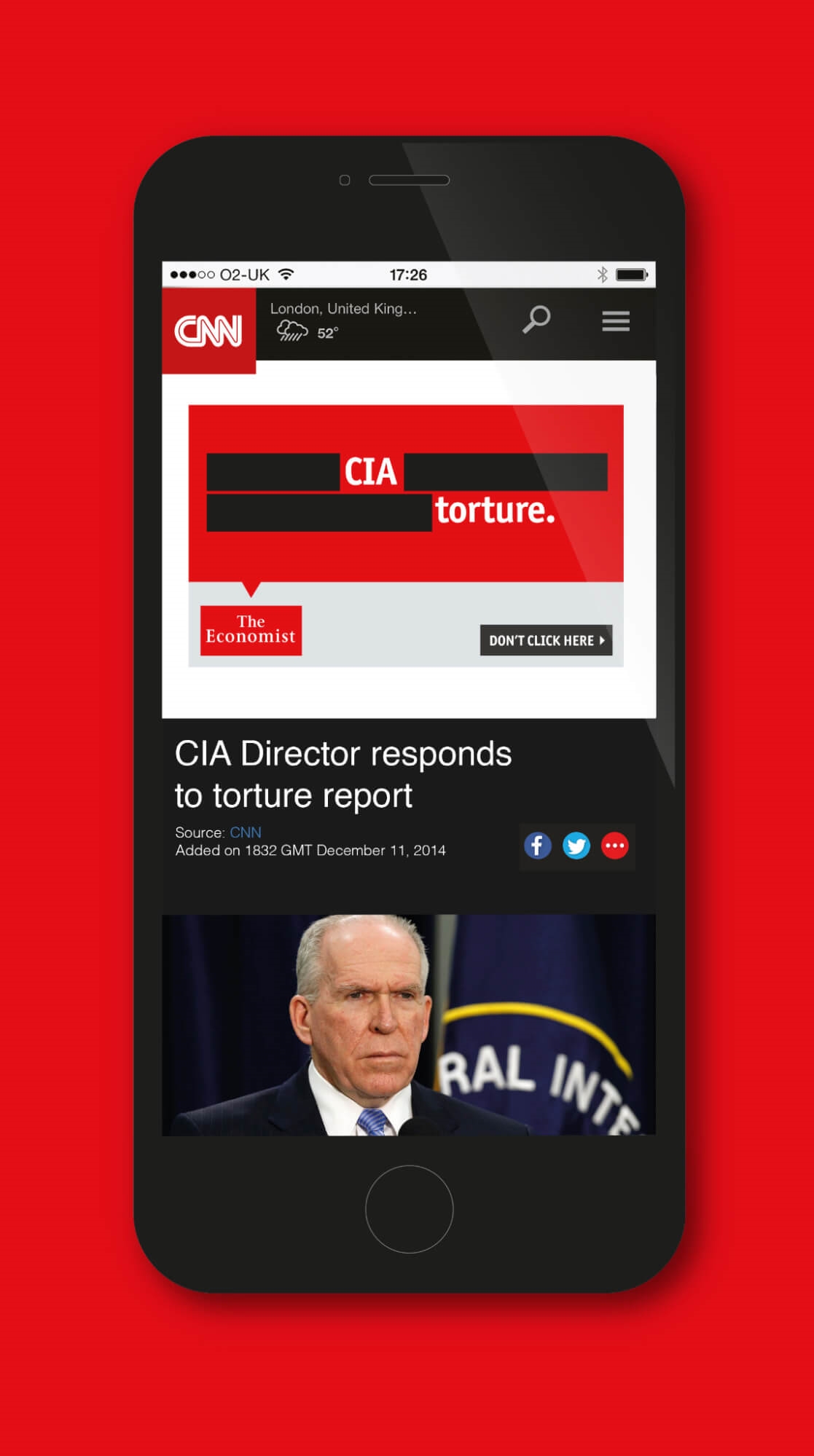
From more than 60 targeted ad versions, The Economist generated 650,000 prospects. 3.6 million people took action after seeing the ads. And the campaign return on investment was 10:1 on a £1.2 million budget.
In terms of sentiment, awareness grew by 64%, consideration by 22% and “willingness to recommend” by 10%.
How to use programmatic advertising to reach your target audience
For programmatic advertising to work effectively and efficiently, you need:
1. The right data
2. The right model
3. Continual tracking
1. Use the right data
Programmatic advertising is only as good as the data you have to work from. Advertisers will have three tiers of data to inform their programmatic marketing strategy.
- First-party data: The data advertisers hold on their customers
- Second-party data: The data collected and shared by someone else, like an agency (often used when there isn’t enough first-party data on a segment)
- Third-party data: The data sold to the advertiser by an external data collection source (often used when targeting a new segment you don’t have any data on)
2. Find the right model
The tech you use to buy programmatically is key in making an impact.
The most common method is going through an agency and using a DSP to buy advertising with the help of automation.
Another option is to run programmatic in-house. According to Bannerflow, more brands are shifting towards this method to improve transparency.
“…bringing programmatic buying in-house means brands have increased transparency across the whole process. This helps businesses to heighten the effectiveness of campaigns by improving reach, lowering ad spend and increasing efficiency.
Programmatic advertising has established itself as a key digital marketing tool across the industry. How effective programmatic can be in terms of efficient targeting at scale helps brands to quickly identify where ad spend needs to be weighted. This can help to explain why many businesses across the world are choosing to create capacity to handle this effort internally.”
In theory, buying programmatic can be done with access to a DSP and a credit card. But it’s a big step to take.
If you’re new to programmatic marketing, start by partnering with a reputable agency. This will allow you to hit the ground running with your advertising.
Transition to an in-house programmatic team can be done gradually as you build up an understanding of what programmatic entails.
3. Continual tracking
Whether you run your programmatic advertising or have an agency work on your behalf, ensure you’re on top of your campaigns.
Pair real-time analytics with qualitative data gathered from customer surveys and sales conversations to deliver the right mix of advertising for your audience.
Measure the success of campaigns closely from start to finish, tweaking copy, creative and audience settings and running continued A/B tests where required. This will help to reduce wasted spend and give you the best possible ROI.
Experiment with new and emerging platforms and channels
Everyone fights for supremacy over high-value keywords on Facebook and Google Ads. You need to stand out by trying something new.
By experimenting and testing emerging platforms, you can access an untapped market at a fraction of the cost of the more established players.
For example, Reddit, which has long been notoriously hostile towards ads, has proven to be successful for several brands.
Duracell received more than 250 million impressions and a 16.3% increase in brand awareness from ads on the platform.
And Woodchuck Hard Cider’s promoted post gained over 20 million impressions and over 5,000 comments, giving the company its highest sales month for seven years:
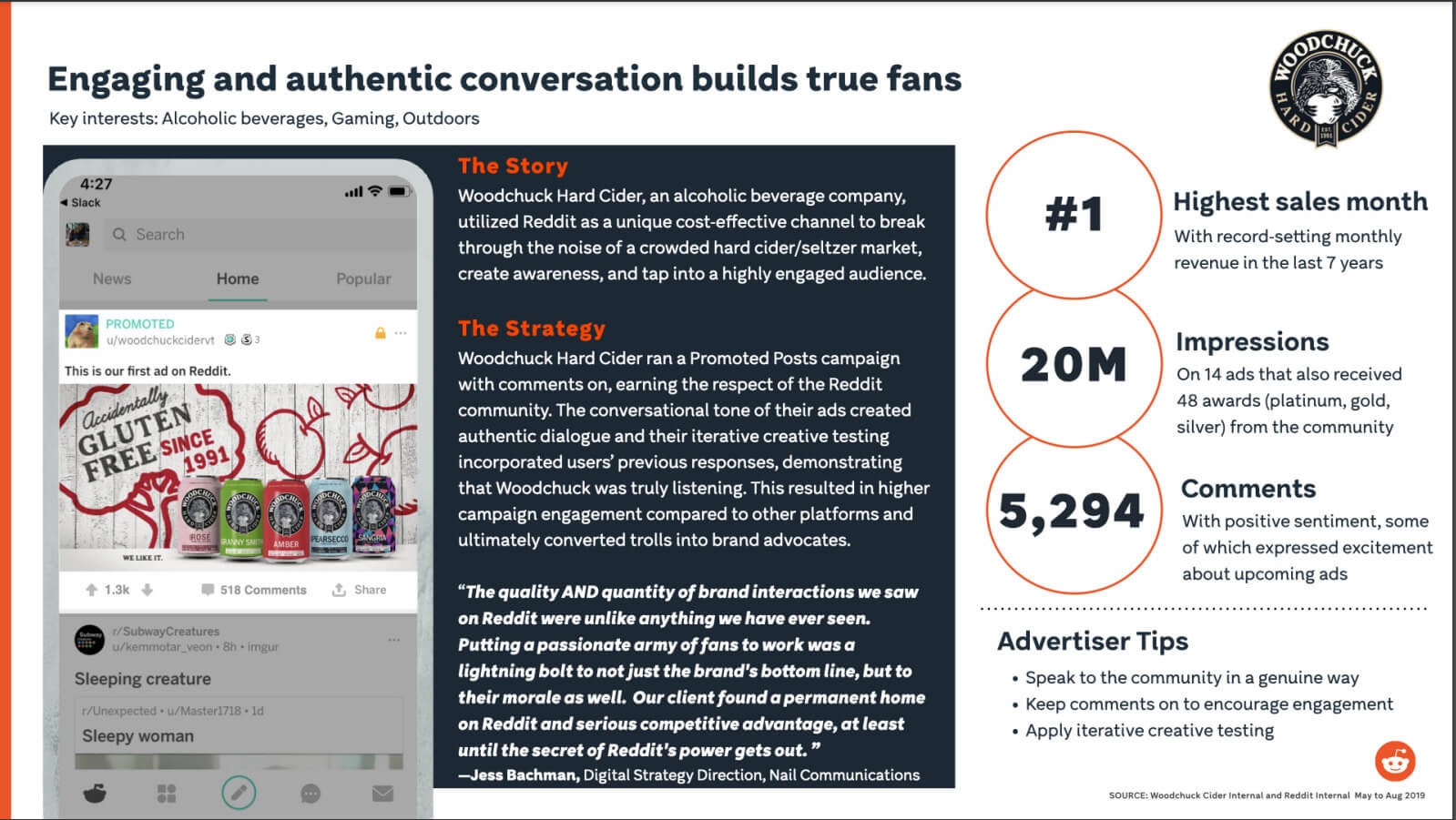
Because emerging platforms like Reddit are less saturated than Facebook and Instagram, CPMs and CPCs are lower, meaning you get more bang for your advertising buck.
This was proven in experiments run by Agorapulse. When comparing Reddit to Instagram, Twitter, and Facebook, impressions and clicks were higher and CPC was lower on Reddit.
So, which emerging platforms should you have your eye on?
According to EmberTribe, these are the current up-and-coming players:
Not all of these platforms will be well suited to your brand (BuySellAds, for instance, is primarily focused on SaaS tech rather than consumer products).
Therefore, it’s important to lay solid foundations before adding anything new to your advertising strategy.
Here are some best practices to help you do this:
1. Assess the strength of each platform or channel
Try to understand which audiences use these platforms and why. To find which platforms are worth a closer look, ask:
- Who is the audience?
- What market penetration does the platform or channel have?
- What sort of behaviour does it create?
- What is the use case?
2. Find out if the platform or channel fits with your core audience
How do your audience’s habits and preferences fit with the general demographics and user behavior of the platform or channel?
The channels with the most overlap between your audience and the new audience are where you’ll find the best success for your ads.
3. Ensure the platform or channel supports your business objectives
Any new addition to your digital advertising strategy must tie into your goals.
For example, if your goal is to reach more people, digital audio streaming platforms like Spotify or Pandora can help you meet that goal. However, if your goal is to foster loyalty, a more community-based platform like Reddit or Quora may be better suited.
Assess the strengths and weaknesses of each platform independently to see how it can help fulfill your aims.
4. Check that the platform or channel is a good fit stylistically
Any platform or channel that you choose is a reflection of your brand. You need to engage your audience in ways that fit with how they use their channels.
Look at whether your tone, voice, and creative direction fit with how organic content is consumed.
Will you need to adapt your creative guidelines to suit the audience and specific ad placements? This may require additional resources to produce the right type of creative. You’ll then need to decide whether this is worth it for the audience you can access.
5. Start small and build
It’s hard to tell how successful a new platform will be until the data starts rolling in. Therefore, it’s best to play it safe. To get started:
- Look at what successful brands are doing with their ads and see how you can adapt them to your campaigns
- Test messaging that performed well on other ad platforms to see how well it works on an emerging channel
- Move some budget over from channels with diminishing returns
- Once you know the new channel is working well, move more budget over
What great ad copy and creative looks like
Promotion PR aside, the success of your digital advertising strategy comes down to the strength of your creative.
As well as cutting through the noise and grabbing attention, great advertising must generate strong brand recall while conveying a message that people can remember.
In other words, a person must be able to remember who you are and what you said. Or as advertising pioneer Bill Bernbach said:
“Nobody counts the number of ads you run; they just remember the impression you make.”
A good example of this is Nike’s “Just Do It” campaign. Those three words don’t belong to Nike, but most people remember them as being related to Nike’s motivational campaign.
According to MetrixLab, who conducted “numerous advertising meta-analyses across more than 20 different verticals, and in every major region globally,” 12 themes are most common in the strongest digital ad creative:
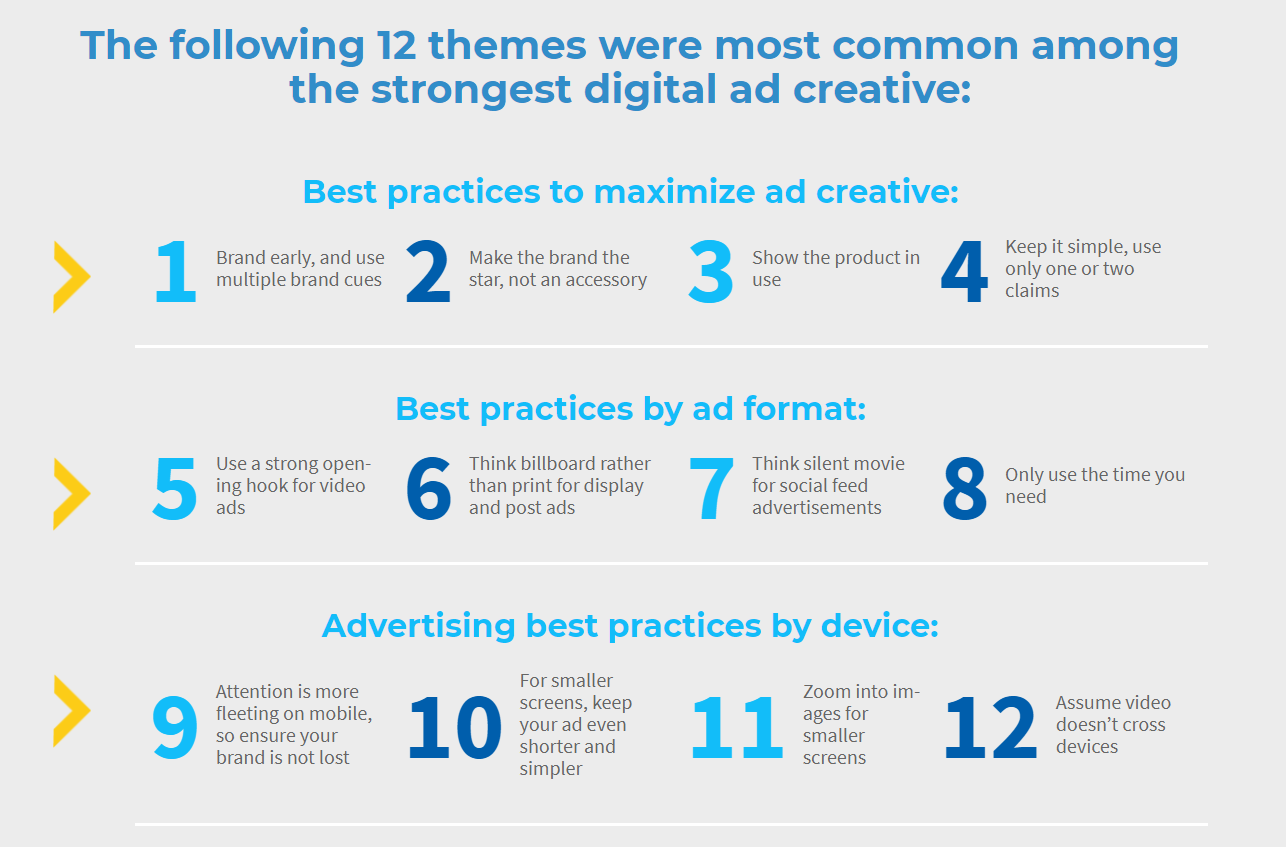
Let’s look at some examples of brands that hit these themes to inspire your ad creation.
1. Adobe
Abobe’s display ad combines eye-catching imagery with simple copy:

By splitting the photo to look like a before and after, Adobe shows how its software can transform a photo in the simplest way possible.
The copy serves as a call to action that resonates with the brand’s target audience of creatives, including designers, graphic designers, and video editors.
Images grab attention. Use them to do the heavy lifting in your ads.
2. Disney+
Disney+ uses evocative imagery and an enticing CTA to inspire action:

The copy reinforces this: “Stream the best stories in the world”.
The ad is then capped off with an offer for users to start a free trial, eliminating risk in the minds of undecided customers while rewarding those looking for a good deal.
3. LinkedIn
LinkedIn’s social media customer story video uses social proof to sell its Sales Navigator feature:
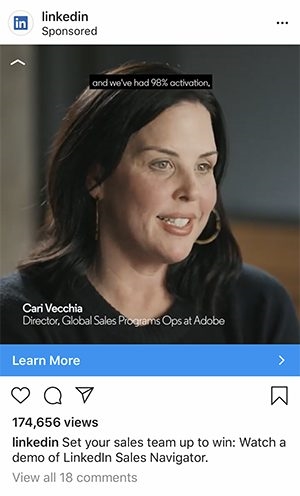
With 79% of people saying they trust reviews as much as recommendations from friends and family, LinkedIn drives home their credibility by using real people in videos.
The video itself uses subtitles. As many as 69% of people view videos with the sound off. Adding captions to your social media ads can capture and keep attention, no matter where your audience is viewing it.
The copy is short and sweet, and the CTA is clear, allowing viewers to learn more without leaving Instagram.
4. Urban Decay
Urban Decay’s ad is another example of combining striking product imagery and clever copy to grab attention with display advertising:

The ad is in keeping with the brand’s edgy marketing and tone of voice, ensuring that it appeals to the right audience of young, beauty-conscious individuals.
The copy says a lot in a few words, using the imagery of “honey” to express the indulgence of the product.
When creating ads, stay true to your brand and audience. Your ads are what entice people, but it’s what you do after that turns them into customers. Your ads should be in keeping with how you present yourself online and offline.
5. Todd Brown Marketing
This split-screen style Facebook ad is proof that advertising isn’t all about big-budget creative:
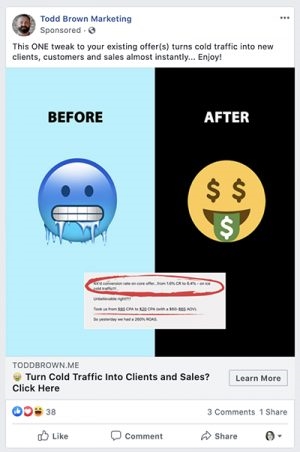
The split-screen design tells a simple story: using this system, marketers can take prospects from cold to hot. This works well with social media advertising, where getting your point across quickly is important to sustain interest.
They’ve also leaned on short, benefit-driven copy. To compel your target audience, show them how you can make their lives easier and do it quickly.
6. Mailchimp
Mailchimp’s search ads increase the potential of its ad by using sitelinks.
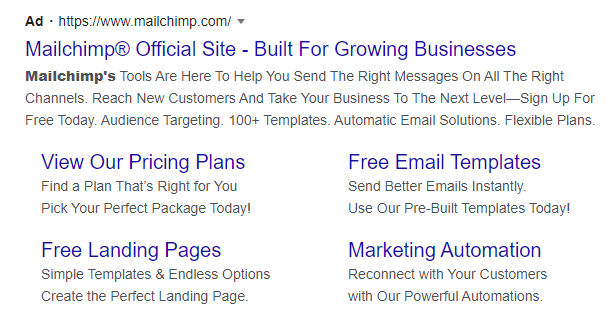
Sitelinks appear at the foot of Google Ads and can be used to segment the searchers in SERPs, sending targeted traffic to your landing pages and increasing conversions.
Mailchimp’s ad copy also leads with benefits. It calls out ways to make the customers’ lives easier, like the ease of sending emails and creating the perfect landing page.
Like Disney+, the word “free” is used several times to eliminate risk and inviting users off the fence.
Whatever kind of ad you’re running for digital advertising campaigns, you’ll be well served by following advertising industry legend Leo Burnett’s advice:
“Make it simple. Make it memorable. Make it inviting to look at. Make it fun to read.”
Conclusion
As ad spend grows in the coming years, competing on major platforms will become harder for small and large brands alike.
Experimenting with different strategies and running ad campaigns on less saturated platforms will allow you to maintain your competitive edge without having to rely on money as the dominant factor.
Test some of the strategies, channels and platforms we’ve covered in this article. Start small and measure results. As the data rolls in, you’ll begin to see where’s best to delegate your resources.
Most importantly, create ads and content that deliver value. As more consumers take charge of what they see online, advertising that helps prospects solve problems or achieve their aims is what will win.
Digital & Social Articles on Business 2 Community
(69)






